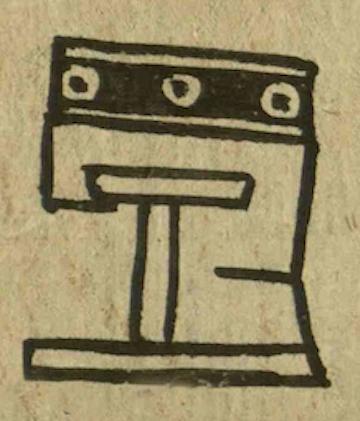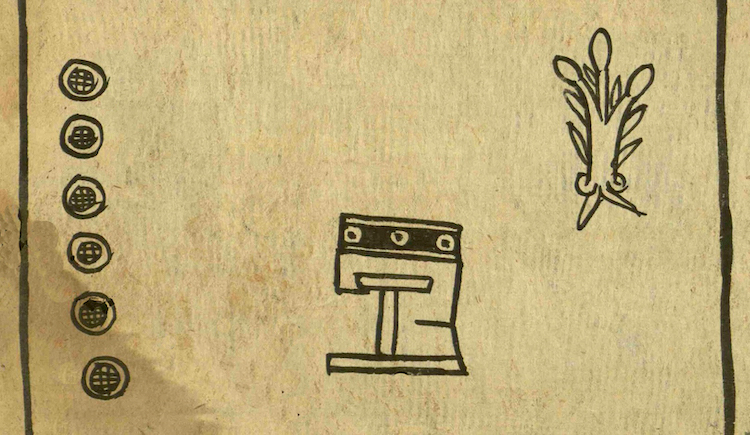tecpan (HJ276:79pt3:233r)
This simplex glyph shows a tecpan in profile facing to the left. It sports a typical colored band, in this case black, with a row of three white concentric circles just below the roof. Thin white stripes appear above and below this band with the circles. The entryway is framed with T-shaped beams. A platform extends out from the entryway.
Robert Haskett
This glyph appears on a pictorial manuscript submitted as evidence during a land dispute between the Cuernavacan community of Temimiltzinco and the Marquesado del Valle. On or around October 23, 1549, the petitioners, Fabian Aquinahuacal and Diego Tequepaneca, alleged that six years previously the Marqués del Valle had usurped the property in question, known as Acamilli, and planted it with mulberry trees (also depicted on the manuscript) as part of his attempt to establish the silk industry in the area. The petitioners assert that this land had belonged to the community before its loss. The pictorial forms part of the so-called Códice del Marquesado del Valle. Since the petitioners state that the property in dispute had belonged to the community of Temimiltzinco, the tecpan may have been pictured on it to underline this claim, standing for what the Spanish gloss refers to as a sujeto in one place, and a pueblo in another. Since there is no Nahuatl text associated with these records the word that would have been used by the Nahua inhabitants to describe their community is not certain. For several works with information about and some analysis of the Códice del Marquesado del Valle, see Códices indígenas de algunos pueblos del Marquesado del Valle de Oaxaca (México: Talleres Gráficos de la Nación, 1933 and Editorial Innovaciób, S.A., 1983; Santiago Sánchez, Armando, Códices del Marq;uesado del Valle de Oaxaca (México: Archivo General de la Nación, 2003); Von Mentz, Brigida, Cuauhnáhuac 1450-1695, su historia indígena y documentos en "mexicano." Cambio y continuidad de una cultura nahua (México: Miguel Ángel Porrú, 2008.
Robert Haskett
1549
Robert Haskett
architecture, construction, buildings, politics, power, governance, social hierarchy, elites, wooden things, arquitectura, construcción, edificios, palacios, poder, gobierno, jerarquía social, madera, xiuhpohualli, turquesa, xihuitl

tecpan, royal palace, https://nahuatl.wired-humanities.org/content/tecpan
tecpancal(li), royal palace, https://nahuatl.wired-humanities.org/content/tecpancalli
la casa real, o el palacio
Stephanie Wood
Single-page codex, Archivo General de la Nación, México, Ramo de Hospital de Jesús, leg. 276, exp. 79, pt. 3, fol. 233r.
The Archivo General de la Nación (AGN), México, holds the original manuscript. This image is published here under a Creative Commons license, asking that you cite the AGN and this Visual Lexicon of Aztec Hieroglyphs.




